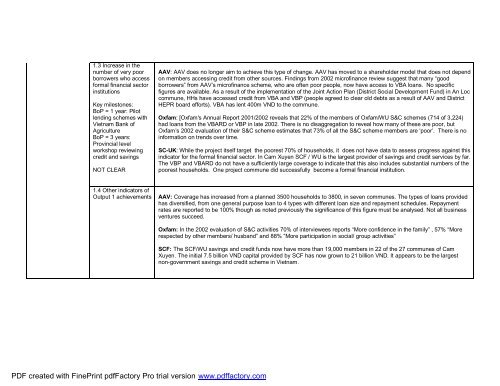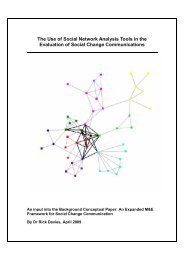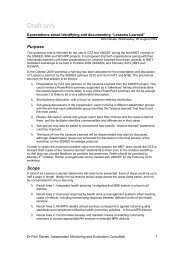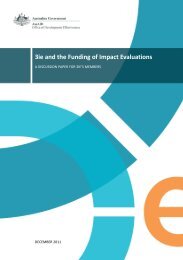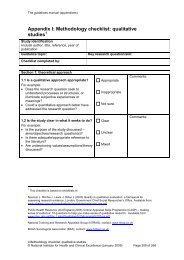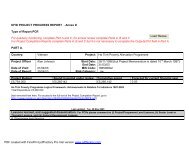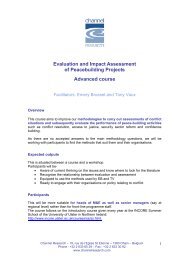DFID 2003 Ha Tinh PCR.pdf - Monitoring and Evaluation NEWS
DFID 2003 Ha Tinh PCR.pdf - Monitoring and Evaluation NEWS
DFID 2003 Ha Tinh PCR.pdf - Monitoring and Evaluation NEWS
You also want an ePaper? Increase the reach of your titles
YUMPU automatically turns print PDFs into web optimized ePapers that Google loves.
1.3 Increase in the<br />
number of very poor<br />
borrowers who access<br />
formal financial sector<br />
institutions<br />
Key milestones:<br />
BoP = 1 year: Pilot<br />
lending schemes with<br />
Vietnam Bank of<br />
Agriculture<br />
BoP = 3 years:<br />
Provincial level<br />
workshop reviewing<br />
credit <strong>and</strong> savings<br />
NOT CLEAR<br />
AAV: AAV does no longer aim to achieve this type of change. AAV has moved to a shareholder model that does not depend<br />
on members accessing credit from other sources. Findings from 2002 microfinance review suggest that many “good<br />
borrowers” from AAV’s microfinance scheme, who are often poor people, now have access to VBA loans. No specific<br />
figures are available. As a result of the implementation of the Joint Action Plan (District Social Development Fund) in An Loc<br />
commune, HHs have accessed credit from VBA <strong>and</strong> VBP (people agreed to clear old debts as a result of AAV <strong>and</strong> District<br />
HEPR board efforts). VBA has lent 400m VND to the commune.<br />
Oxfam: [Oxfam's Annual Report 2001/2002 reveals that 22% of the members of Oxfam/WU S&C schemes (714 of 3,224)<br />
had loans from the VBARD or VBP in late 2002. There is no disaggregation to reveal how many of these are poor, but<br />
Oxfam’s 2002 evaluation of their S&C scheme estimates that 73% of all the S&C scheme members are ‘poor’. There is no<br />
information on trends over time.<br />
SC-UK: While the project itself target the poorest 70% of households, it does not have data to assess progress against this<br />
indicator for the formal financial sector. In Cam Xuyen SCF / WU is the largest provider of savings <strong>and</strong> credit services by far.<br />
The VBP <strong>and</strong> VBARD do not have a sufficiently large coverage to indicate that this also includes substantial numbers of the<br />
poorest households. One project commune did successfully become a formal financial institution.<br />
1.4 Other indicators of<br />
Output 1 achievements<br />
AAV: Coverage has increased from a planned 3500 households to 3800, in seven communes. The types of loans provided<br />
has diversified, from one general purpose loan to 4 types with different loan size <strong>and</strong> repayment schedules. Repayment<br />
rates are reported to be 100% though as noted previously the significance of this figure must be analysed. Not all business<br />
ventures succeed.<br />
Oxfam: In the 2002 evaluation of S&C activities 70% of interviewees reports “More confidence in the family” , 57% “More<br />
respected by other members/ husb<strong>and</strong>” <strong>and</strong> 88% “More participation in social/ group activities”<br />
SCF: The SCF/WU savings <strong>and</strong> credit funds now have more than 19,000 members in 22 of the 27 communes of Cam<br />
Xuyen. The initial 7.5 billion VND capital provided by SCF has now grown to 21 billion VND. It appears to be the largest<br />
non-government savings <strong>and</strong> credit scheme in Vietnam.<br />
PDF created with FinePrint <strong>pdf</strong>Factory Pro trial version www.<strong>pdf</strong>factory.com


